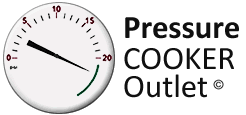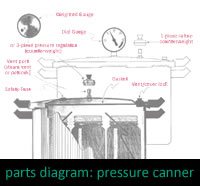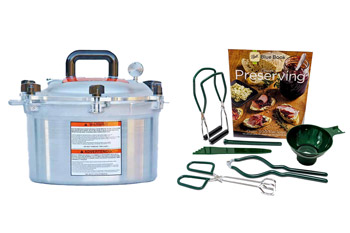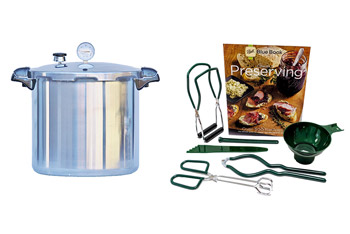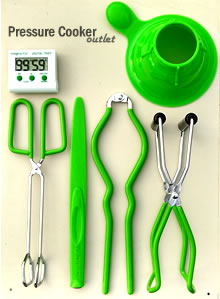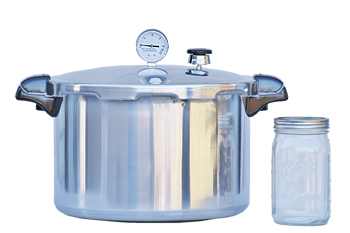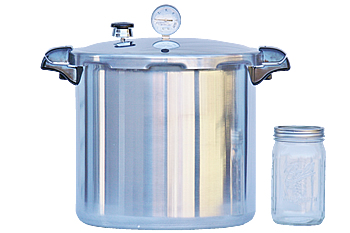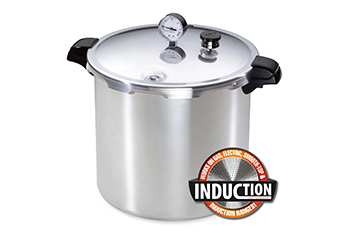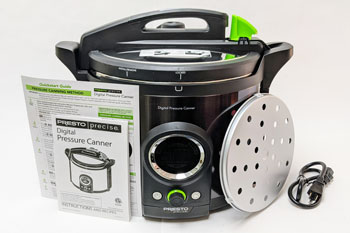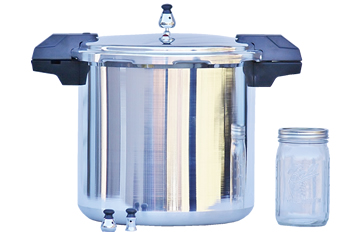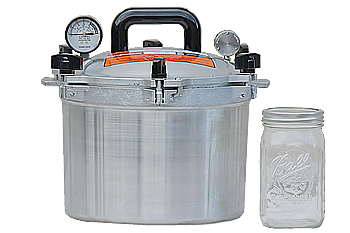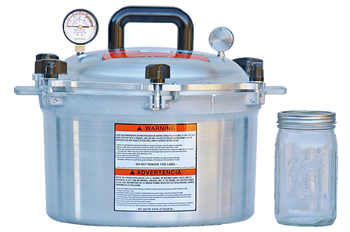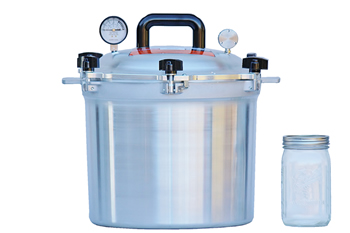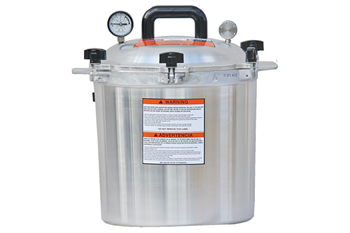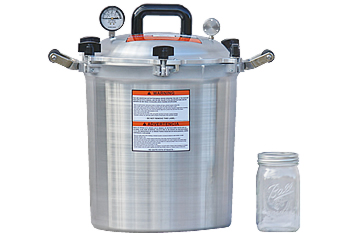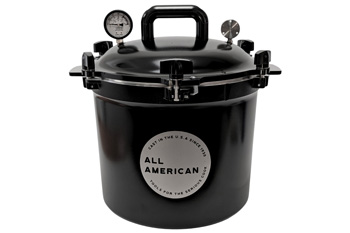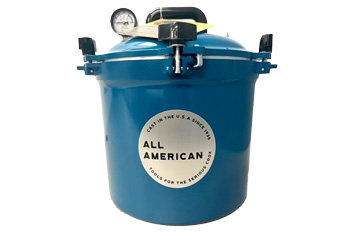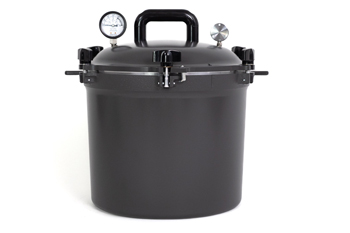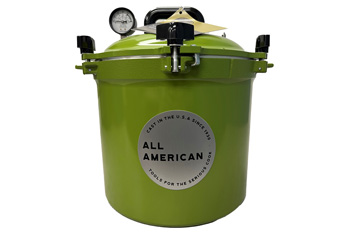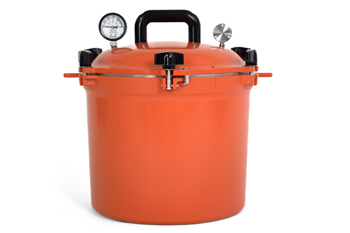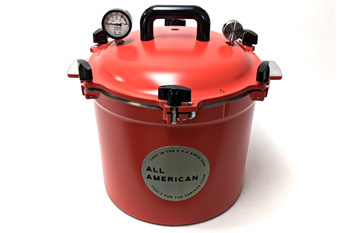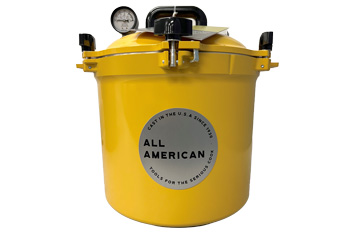Pressure Canners
Pressure cookers for canning and home food preservation. Canning pressure cookers are different from pressure cookers. (1) They are large for canning jars and (2) their size achieves stable processing times, temperatures and pressures that meet home food preservation standards. Lower your food bill and feed your family. We offer the biggest variety of Pressure Canner Brands and sizes to choose from.
Gasket or metal to metal seal?Big or Small Pressure Canner?
If home canning is to be done regularly, it pays to have a good-sized pressure canner in perfect working order.
Our Number OpcAA910
Our Number OpcAA915
Our Number OpcAA921
Our Number OpcAA925
Our Number OpcAA930
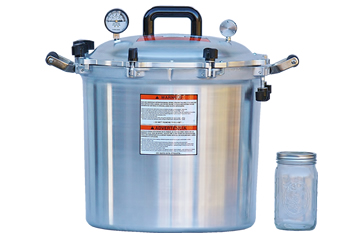
All American Pressure Canner 41 Quart
Price: $649.95
Out of Stock
Available for Backorder
ETA: Coming January 2026
Our Number OpcAA941
Our Number OpcAA921BK
Our Number OpcAA921BL
Our Number OpcAA921GY
Our Number OpcAA921GR
Our Number OpcAA921OR
Our Number OpcAA921RD
Our Number OpcAA921YL
Frequently Asked Pressure Canning Questions
Gasket or metal to metal seal?
The four top row pressure canners are by Presto and Mirro. These seal using a rubber gasket. Our line of Presto and Mirro pressure canners are great for home canning or cooking large quantities of food quickly. We also offer Pressure Canners from Wisconsin Aluminum Foundry, more commonly known as, the All American Pressure Canners. The remaining rows of canners are All American Pressure Canners, made in the USA that use a metal to metal seal. All American Canners hold steam in under pressure without a gasket. The advantage? Simply no worries about keeping your gasket in perfect working condition.Big or Small Pressure Canner?
The size of your pressure canner should be suitable to the kind of jars you would like to use and the probable number to be handled at one time. For home use, pressure canners from 16-to 23- quart capacity have been found most satisfactory. While large pressure canners are available, they are often too heavy and too awkward to handle. Smaller pressure cookers (below a 12- Quart capacity) are intended for cooking rather than canning. They only fit a small number of jars, and it's almost impossible to operate them so that the pressure does not fluctuate during the processing period.Pressure Canning-for nonacid foods
A pressure canner is required for processing meats, practically all vegetables except tomatoes, and other non acid foods. The pressure canner is specifically designed to obtain temperatures higher than can be reached with a boiling water or water bath canner.Pressure Canning Jars: Basic Steps
Most importantly: check jars, lids and bands. Examine them carefully to make sure there are no nicks, chips, cracks or sharp edges. Recycle imperfect jars. Use new flat metal lids each time. Wash jars and rings in hot soapy water and rinse with hot water. It is not necessary to sterilize jars for pressure canning.
Most foods may be packed raw in jars. Raw food should be packed tightly because it shrinks during processing. Food may be also preheated or partially cooked and packed hot in jars. Hot food should be packed fairly loosely. Allow headspace between food and jar closure for a good seal. Release trapped air bubbles by using a bubble remover spatula down the sides of the jar. Wipe rim of jars free from seeds, pulp, liquid, etc. Secure lids and process according to canner manufacturer instructions and recipe.
Place jars on rack in a canner containing 1 to 2 inches of water. Leave ample space between jars to permit free circulation of steam.
When processing time is completed, turn off heat. Allow pressure to reduce normally. It takes about 25 minutes for the pressure to drop in a pan filled with jars. Once pressure has dropped, remove the regulator weight / control value and the cover (tilt the far side up so the steam escapes away from you). Lift jars out and sit on several thickness of cloth (never a cold surface). Do not tighten screw bands. After 12 hours, remove the screw bands.
Did My Jars Seal?
Examine the jars for leaks. To test two-piece metal lids, tap them with a teaspoon. A clear ring is a sign of a good seal. If a jar leaks, use contents at once or reprocess with a new lid or jar.
Rules for Successful Pressure Canning
1. Be sure all fruits and vegetables are garden fresh and free
from decay.
2. Corn, peas and beans expand during processing period. Pack loosely.
3. When adding liquid to fill jar, keep water level 1/2" below
the top. When adding syrup, fill to within 1 1/2" of top.
4. Do not lift jars by lids when removing them from canner. This
may destroy seal and allow air to enter the jar.
5. Never turn jars upside down to cool and do not stack jars or
store until cooled.
